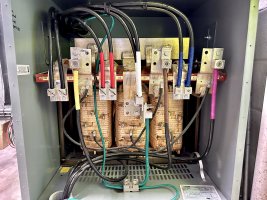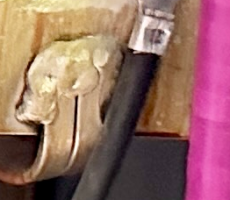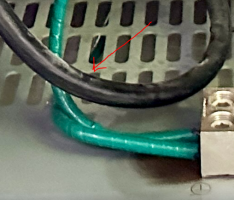Not an NEC pro at all... but would the following not be applicable? Does it fall under 250.102(E)?
2023 NEC (NFPA 70)
300.3(B)
(B) Conductors of the Same Circuit
All conductors of the same circuit and, where used, the grounded conductor and all equipment grounding conductors and bonding conductors shall be contained within the same raceway, conduit body, auxiliary gutter, cable tray, cablebus assembly, trench, cable, or cord unless otherwise permitted in accordance with 300.3(B)(1) through (B)(4).
(1) Paralleled Installations
{omitted for clarity}
(2) Grounding and Bonding Conductors
Equipment grounding conductors shall be permitted to be installed outside a raceway or cable assembly in accordance with 250.130(C) for certain existing installations or in accordance with 250.134, Exception No. 2, for dc circuits. Equipment bonding conductors shall be permitted to be installed on the outside of raceways in accordance with 250.102(E).
...continues {omitted for clarity}
250.102 Grounded Conductor, Bonding Conductors, and Jumpers
...
(E) Installation
Bonding jumpers or conductors and equipment bonding jumpers shall be permitted to be installed inside or outside of a raceway or an enclosure.
(1) Inside a Raceway or an Enclosure
If installed inside a raceway, equipment bonding jumpers and bonding jumpers or conductors shall comply with the requirements of 250.119 and 250.148.
(2) Outside a Raceway or an Enclosure
If installed on the outside, the length of the bonding jumper or conductor or equipment bonding jumper shall not exceed 1.8 m (6 ft) and shall be routed with the raceway or enclosure.
Exception: An equipment bonding jumper or supply-side bonding jumper longer than 1.8 m (6 ft) shall be permitted at outside pole locations for the purpose of bonding or grounding isolated sections of metal raceways or elbows installed in exposed risers of metal conduit or other metal raceway, and for bonding grounding electrodes, and shall not be required to be routed with a raceway or enclosure.
(3) Protection
Bonding jumpers or conductors and equipment bonding jumpers shall be installed in accordance with 250.64(A) and (B).
...continues {omitted for clarity}




